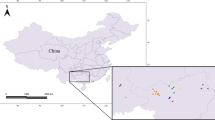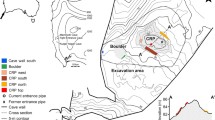Abstract
The existence of cavernicolous sculpin (here allocated to Cottus carolinae, banded sculpin, and referred to as grotto sculpin), in the karst regions of Perry County, Missouri, first came to our attention in 1991. Examination of 35 caves in Missouri, 96 in Illinois, 17 in Tennessee, two in Indiana, and 11 in Arkansas revealed that banded sculpin are common in cave habitats; however, grotto sculpin are limited to two karst areas of Perry County, Missouri, where they are known from only six cave systems. These caves and their streams are extensive and apparently provide a unique habitat compared to other karst systems; this may be a critical factor in the present restricted distribution of the grotto sculpin. Grotto sculpin occupy pools and riffles of cave streams, and occur over a variety of substrates, from sediment to breakdown. Density estimates in Mystery and Running Bull caves were 0.29 and 0.63 individuals m-2, respectively. Grotto sculpin have small eyes (1–6% SL vs. 6–10% SL in epigean samples), significantly reduced pigmentation (including nearly complete loss of dorsal saddles), a reduction in pelvic fin ray number (from 4+4 elements to often 4+3 , or 3+3), and enlarged cephalic lateralis pores (e.g., mandibular pores of cavernicolous samples are 2–3 times those of epigean stream samples). Multivariate analyses of body shape revealed statistically significant separation of epigean and hypogean samples, with eye size highly variable, but smallest in the Running Bull Cave population. We interpret these results as representative of losses associated with long-term cave habitation. Caves of Perry County provide ample habitat for grotto sculpin, but because the caves are located downgradient of the city of Perryville and an intensively farmed landscape, point and non-point source pollution threaten their continued existence. Escape of farm-pond fishes through the extensive sinkhole network in Perry County has increased potential predation pressure on grotto sculpin by channel catfish, Ictalurus punctatus, and other species normally excluded from cave environments.
Similar content being viewed by others
References
Avise, J.C. & R.K. Selander. 1972. Evolutionary genetics of cavedwelling fishes of the genus Astyanax. Evolution 26: 1–9.
Bretz, J.H. & S.E. Harris, Jr. 1961. Caves of Illinois. Ill. State Geol. Surv. Rep. Invest. (215): 1–87.
Cooper, J.E. 1978. American cave fishes and salamanders. Nat. Speleol. Soc. Bull. 40: 89.
Cooper, J.E. & R.A. Kuehne. 1974. Speoplatyrhinus poulsoni, a new genus and species of subterranean fish from Alabama. Copeia 1974: 486–493.
Eigenmann, C.H. 1909. Cave vertebrates of America. Carnegie Institution of Washington, Washington, D.C. 241 pp.
Elliott, W.R. 2000. BelowMissouri karst. Miss. Conserv. 61: 4–7.
Field, M.S. 1989. The vulnerability of karst aquifers to chemical contamination. pp. 130–142. In: J.E. Moore, A.A.
Zaporozec, S.C. Scallany & T.C. Varney (ed.) Proceedings of the International Conference on Recent Advances in Ground-Water Hydrology, American Institute of Hydrology, Minneapolis.
Gordon, M.S. & D.E. Rosen. 1962. A cavernicolous form of the poeciliid fish Poecilia sphenops from Tabasco, Mexico. Copeia 1962: 360–368.
Greenberg, L.A. & D.A. Holtzman. 1987. Microhabitat utilization, feeding periodicity, home range and population size of the banded sculpin, Cottus carolinae. Copeia 1987: 19–25.
Groombridge, B. (ed.) 1992. Global biodiversity, first edition. Chapman & Hall, London. 585 pp.
Helfman, G.S., B.B. Collette & D.E. Facey. 1997. The diversity of fishes. Blackwell Science, Inc., Malden. 528 pp.
Helling, C.S. 1986. Agricultural pesticides and ground water quality. pp. 161–175. In: Agricultural Impacts on GroundWater (Omaha, Nebraska), Proc. Nat. Water Well Assoc., Dublin, Ohio.
Hubbs, C.L. & W.T. Innes. 1936. The first known blind fish of the family Characidae: a new genus from Mexico. Occas. Pap. Mus. Zool. Univ. Mich. (342): 1–7.
Hubbs, C.L. & K.F. Lagler. 1974. Fishes of the Great Lakes region. University of Michigan Press, Ann Arbor. 213 pp.
House, S. 1976. Karst and cave distribution in Perry County. Southeast. Caver 2: 13–14.
Jenkins, R.E. & N.M. Burkhead. 1994. Freshwater fishes of Virginia. American Fisheries Society, Bethesda. 1079 pp.
Libra, R.D., G.R. Hallberg, B.E. Hoyer & L.G. Johnson. 1986. Agricultural impacts on ground water quality: the Big Spring basin study, Iowa. pp. 253–273. In: Agricultural Impacts on Ground Water (Omaha, Nebraska), Proc. Nat. Water Well Assoc., Dublin, Ohio.
Mitchell, R.W.,W.H. Russell & W.R. Elliott. 1977. Mexican eyeless characin fishes, genus Astyanax: environment, distribution, and evolution. Spec. Publ. Mus. Texas Tech. Univ. (12): 1–89.
Mitchem, P.S., G.R. Hallberg, B.E. Hoyer & R.D. Libra. 1988. Ground-water contamination and land management in the karst area of northeastern Iowa. pp. 442–458. In:D.M. Neilsen & A.I. Johnson (ed.) Ground-Water Contamination: Field Methods, American Society for Testing and Materials Special Technical Publication 963, ASTM, Philadelphia.
Mohr, C.E. 1950. Ozark cave life. Nat. Speleol. Soc. Bull. 12: 3–11.
Padgett, A. & B. Smith. 1987. On rope. North American vertical rope techniques. National Speleological Society, Huntsville. 341 pp.
Page, L.M. & B.M. Burr. 1991. Field guide to freshwater fishes, North America north ofMexico. Houghton Mifflin Co., Boston. 432 pp.
Peck, S.B. & J.J. Lewis. 1978. Zoogeography and evolution of the subterranean invertebrate fauna of Illinois and southeastern Missouri. Nat. Speleol. Soc. Bull. 40: 39–63.
Pflieger, W.L. 1997. The fishes of Missouri, revised edition. Missouri Department of Conservation, Jefferson City. 372 pp.
Poly, W.J. & C.E. Boucher. 1996. Nontroglobitic fishes in caves: their abnormalities, ecological classification and importance. Amer. Midl. Nat. 136: 187–198.
Rea, T. (ed.). 1987. Caving basics, revised edition. National Speleological Society, Huntsville. 128 pp.
Robins, C.R. 1954. A taxonomic revision of the Cottus bairdi and Cottus carolinae species groups in eastern North America (Pisces, Cottidae). Doctoral Dissertation, Cornell University, Ithaca. 248 pp.
Robins, C.R. & R.R. Miller. 1957. Classification, variation, and distribution of the sculpins, genus Cottus, inhabiting Pacific slope waters in California and southern Oregon, with a key to the species. Calif. Fish Game 43: 213–233.
Romero, A. 1983. Introgressive hybridization in the Astyanax fasciatus (Pisces: Characidae) population at La Cueva Chica. Nat. Speleol. Soc. Bull. 45: 81–85.
SAS Institute, Inc. 1985. SAS user's guide: statistics. Statistical Analysis Systems Institute, Inc., Cary. 584 pp.
Smart, P.L. & H. Friederich. 1987. Water movement and storage in the unsaturated zone of a Carboniferous limestone aquifer, Mendip Hills, England. pp. 59–87. In: Environmental Problems in Karst Terranes and Their Solutions (Bowling Green, Kentucky), Proceedings, National Water Well Association, Dublin, Ohio.
Smart, P.L. & S.L. Hobbs. 1986. Characterization of carbonate aquifers: a conceptual base. pp. 1–14. In: Environmental Problems in Karst Terranes and Their Solutions (Bowling Green, Kentucky), Proceedings, National Water Well Association, Dublin, Ohio.
Spear, M. 1995. Considerations in defining the concept of a distinct population segment of any species of vertebrate fish or wildlife. pp. 423–424. In: J.L. Nielsen (ed.) Evolution and the Aquatic Ecosystem: Defining Unique Units in Population Conservation, American Fisheries Society Symposium 17, Bethesda.
Statsoft. 1994. Statistica for the Macintosh, volumes 1–3. Statsoft, Inc., Tulsa. 1062 pp.
Strauss, R.E. & F.L. Bookstein. 1982. The truss: body form reconstructions in morphometrics. Syst. Zool. 31: 113–135.
Unklesbay, A.G. & J.D. Vineyard. 1992. Missouri geology: three billion years of volcanoes, seas, sediments, and erosion. University of Missouri Press, Columbia. 189 pp.
Vandike, J.E. 1985. Movement of shallow groundwater in the Perryville Karst area, southeastern Missouri. Water Res. Rept. (40): 1–56.
Walsh, S.J. & C.R. Gilbert. 1995. New species of troglobitic catfish of the genus Prietella (Siluriformes: Ictaluridae) from northeastern México. Copeia 1995: 850–861.
Williams, P.W. 1985. Subcutaneous hydrology and the development of doline and cockpit karst. Z. Geomorph. 29: 463–482.
Williams, J.D. & W.M. Howell. 1979. An albino sculpin from a cave in the New River drainage of West Virginia (Pisces: Cottidae). Brimleyana 1: 141–146.
Woods, L.P. & R.F. Inger. 1957. The cave, spring, and swamp fishes of the family Amblyopsidae of central and eastern United States. Amer. Midl. Nat. 58: 232–256.
Author information
Authors and Affiliations
Rights and permissions
About this article
Cite this article
Burr, B.M., Adams, G.L., Krejca, J.K. et al. Troglomorphic Sculpins of the Cottus Carolinae Species Group in Perry County, Missouri: Distribution, External Morphology, and Conservation Status. Environmental Biology of Fishes 62, 279–296 (2001). https://doi.org/10.1023/A:1011819922403
Issue Date:
DOI: https://doi.org/10.1023/A:1011819922403




